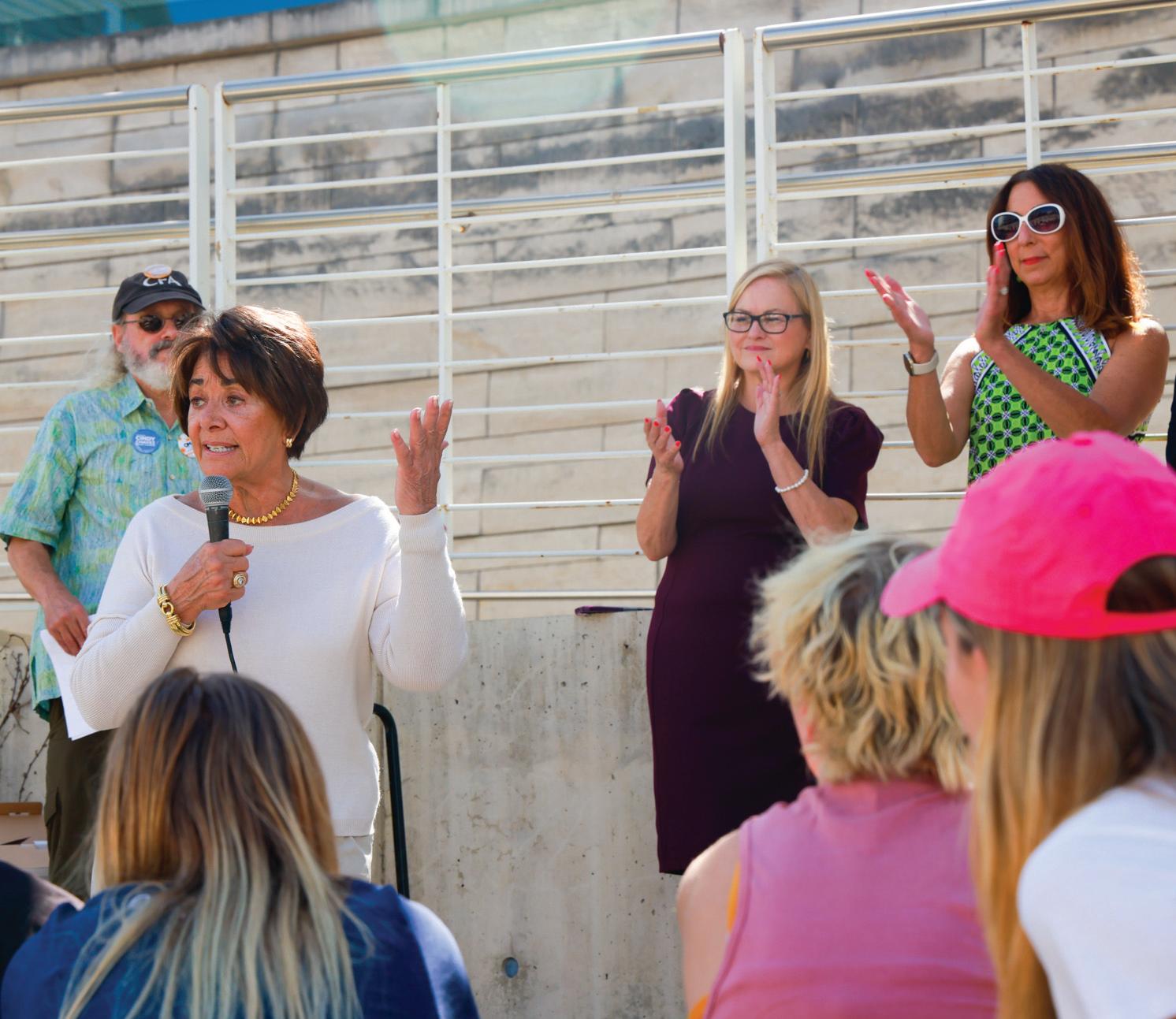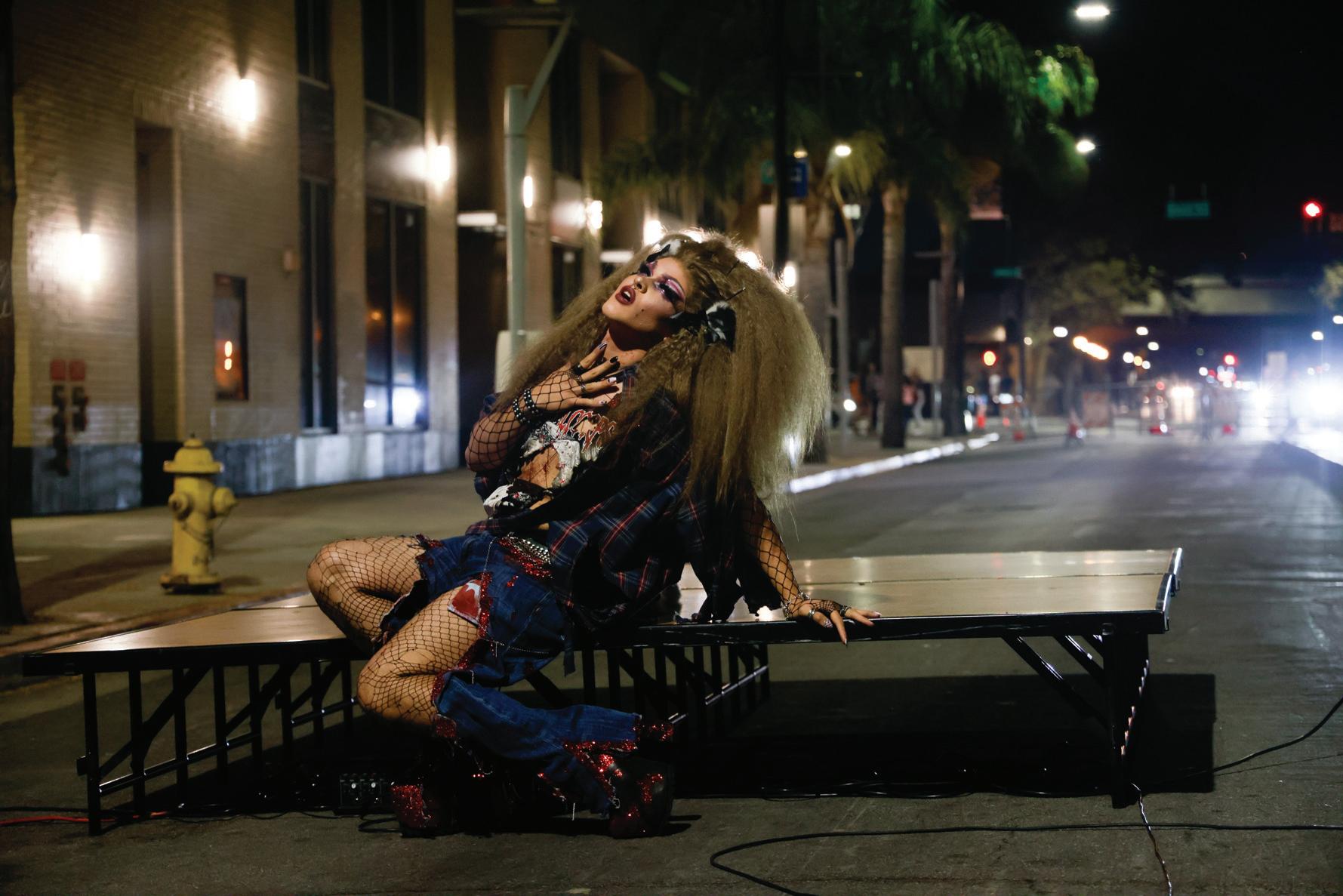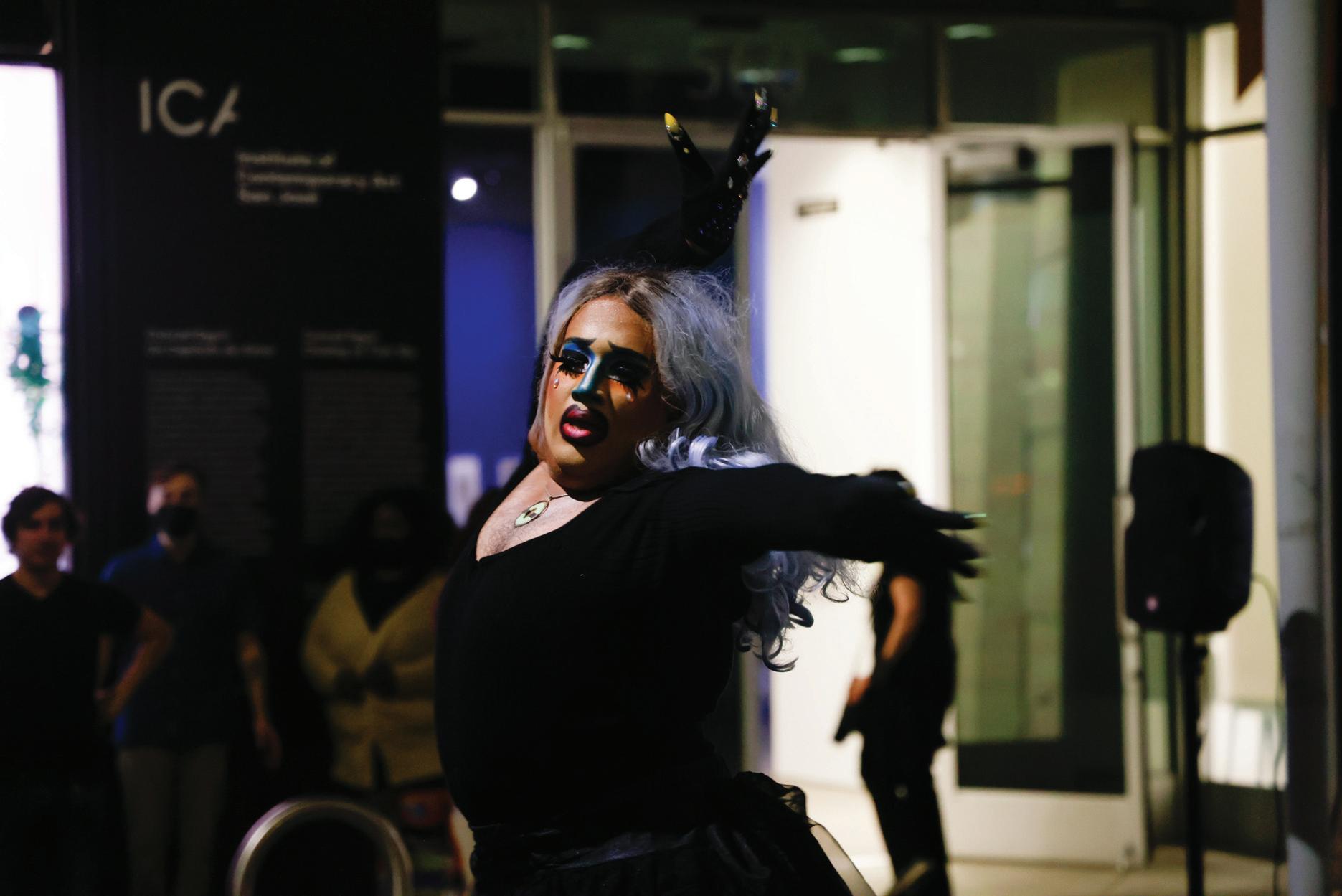San Jose rallies for abortion rights
By Vanessa Tran & Adrian Pereda STAFF WRITERS

Thousands of people across the U.S. rallied for reproductive rights Saturday afternoon including San Jose community members who took to the streets in Downtown San Jose, one month before midterm elections.

That was part of the “Women’s Wave” day of action to emphasize that this year’s midterm elections
is a crucial time to cast ballots for candidates who support abortion rights.
San Jose’s rally, which began at city hall and ended at Plaza de Cesar Chavez Park, featured speakers which included local Planned Parenthood representatives; mayoral candidate Cindy Chavez; state senator candidate Aisha Wahab; Jean Cohen, South Bay Labor Council executive officer; Omar Torres, San Jose District 3 councilmember candidate and other local leaders.
“One of the things that we have to know is that it’s not just abortion rights,” Chavez said. “It’s contraception that’s on the table, it’s gay marriage, it’s people’s individual civil rights.”
Jonathan Karpf, San Jose State emeritus anthropology lecturer, organized the rally and said that protest was an important way for women in San Jose to voice their outrage.
Protesters demonstrate on the sidewalks in front of San Jose City Hall, located a block north of San Jose State, on Saturday afternoon.
The rally was part of a nationwide action, in which protesters in cities across the U.S. marched for reproductive rights before the Nov. 8 midterm elections.
Child Development Center: 50 years later
By Jeremy Martin STAFF WRITER
Carl Foster expressed feelings of nostalgia as he returned to San Jose State campus on Sept. 18, fifty years after he created the university’s Child Development Center.
Foster created the center under the Center for the Study of Contemporary Issues, which was a series of lecture-format classes offered between Fall 1970 and Spring 1972 that was administered by students and taught by SJSU faculty members.

“We were the third effort to start a childcare center,” Foster said.

Foster said the center developed through one of those courses: the Child Care Center Research Action Group.
“I hand picked [15 students to work on the development of the center] because I was determined to succeed,” he said. “I wanted people who weren’t
just looking for an easy class.”
Foster said in creating the center and selecting a location, he and his team needed to ensure it was held up to a high standard and was kid friendly, which included having enough space and short water fountains.
“As a matter of fact, the center started in St. Paul’s United Methodist Church on South 10th Street and that was the first site for the center, it was a brand-new church,” Foster said.
He said the first operational day for the center was on Sept. 18, 1972.
The Child Development Center remains a part of SJSU and is now located on South Eighth Street, just across the street from campus.
Jane Zamora, Child Development Center director, said today, the center works to serve the campus community by providing high-quality and affordable
SERVING SAN JOSE STATE UNIVERSITY SINCE 1934 WWW.SJSUNEWS.COM/SPARTAN_DAILY Volume 159 No. 21 Tuesday, Oct. 11, 2022 NAMED NATIONAL FOUR-YEAR DAILY NEWSPAPER OF THE YEAR FOR 2020-21 IN THE COLLEGE MEDIA ASSOCIATION’S PINNACLE AWARDS
NATHAN
CANILAO | SPARTAN DAILY Seven-month-old Tilden DeVries plays with a toy after his nap time at the Child Development Center, which is located on South Eighth Street, across from San Jose State, on Oct. 5.
NICK ZAMORA | SPARTAN DAILY
ABORTION | Page 2 CHILDREN | Page 2 SJSU affiliates reflect on center’s effects Community members emphasize voting in midterm elections
“The main goal is to get people to vote in November, to vote for Democrats and to vote for Proposition 1, which will enshrine abortion access in the state constitution,” Karpf said during the march.
If Proposition 1 is passed, the California Constitution would be changed to expressly include existing rights to reproductive freedom such as the right to choose whether to have an abortion and use contraceptives, according to California Voter Guide.
If it does not pass, those rights would continue to exist under other state laws, according to the Voter Guide.
Karpf said he encourages San Jose State students to fight against this attack on women and send a message to neo-fascist republicans in Congress.
“What we do know is that the female SJSU students, and only they, along with maybe their medical provider, should have control over their own bodies and their futures,” he said. “Politicians, especially white male politicians, have no business telling them what they can and cannot do with their bodies.”
Lisa Buuck, legal secretary at the Santa Clara County District Attorney’s Office, said she was excited to be able to participate in such a waking moment as a proud woman.

“This is the most important time of our lives right now to fight out the ugliness in this country,” Buuck said.
She said she has had an abortion and wants to support the younger generation’s right to have one too.
“We are going into the handmaid’s tale,” Buuck said. “I heard Arizona is trying to go back into the 1800s. We are a 21st Century country.”
Arizona banned abortions in 1864, banning all abortions except to save the life of the mother, according to Arizona Mirror, an independent and non-profit news organization that focuses on connecting public policy with society.
Abortion is only legal in Arizona if the mother is at 15 weeks, but it is illegal any time after thst period, according to Abortion Finder, an organization that helps people gain access to reproductive healthcare.
Buuck said she’s scared of the
CHILDREN
Women are in charge. Women got the answers. Let’s go. Leave us alone. Give us our rights. Period.
Lisa Buuck
Santa Clara County District Attorney’s Office legal secretary
states that have banned abortions and will no longer go to those places or spend any money there.
Most abortions are now banned in at least 13 states as laws restricting the procedure take effect following the Supreme Court’s decision to overturn Roe v. Wade on June 24, according to an abortion-bans tracking sheet by the New York Times that was last updated on Oct. 7.
Georgia bans abortion at about six weeks of pregnancy, before many women know they are pregnant, according to the New York Times.
In many states, the fight over
abortion access is still taking place in courtrooms, where advocates have sued to block enforcement of laws that restrict the procedure, according to the same tracking sheet.
“Women are in charge. Women got the answers,” Buuck said. “Let’s go. Leave us alone. Give us our rights. Period.”
Isabel, who wished to go by her first name because of privacy concerns, a 33-year-old woman who is a part of Democratic Socialists of America, an organization that advocates for social change in communities and politics,
emphasized that sentiment.
“We need to do much more to fight for bodily autonomy, the right to decide what to do with our own bodies – that means the right to get an abortion on demand without apology, the right to trans-care and all those things,” Isabel said.
Isabel said supporting the National Network of Abortion Funds, an organization that focuses on increasing access to abortions for low-income individuals, can help those who live in states where it is illegal.
“Locally, I think we need to fight against the crisis pregnancy centers that are misleading women every day,” Isabel said.
Pregnancy centers are clinics or mobile vans disguised as health centers that purposely scare, shame, pressure or lie to women out of getting abortions, according to Planned Parenthood, a non-profit organization that
provides reproductive healthcare.
Janet Kitajima, an SJSU lecturer who teaches linguistics and child and adolescent development, said she felt motivated at the rally, she thinks the overturn is a major setback in the U.S. and is hoping the country will recover from this.
Kitajima said she thinks the overturn is a major step back in America and is hoping the country will recover from this.
“My daughters live in California, but I can’t imagine the fear that must go through people in states where abortion has been criminalized,” Kitajima said.
childcare for students who are finishing up their degrees.
The nonprofit center serves children ages 4 months through 5 years and is licensed for 110 children, according to its webpage.
“We prioritize our students, so students first, then faculty, staff and alumni, because the waitlist to come to the center is pretty extensive,” Zamora said regarding who gets priority registration to the center.
She said the program hasn’t been under the department of child and adolescent development program since 2000, which is when it moved to its current building and began being under the direction of Associated Students.
Zamora said the Child Development Center is about more than just childcare.
“We just want to provide a learning environment for the children, so when they are leaving us to go to kindergarten and elementary school, they have all those skills to be successful,” she said.
Zamora said the center doesn’t teach children set lessons or have a main curriculum.
“We take observations on just them when they’re out in the environment, when they’re exploring, interactions when they’re just engaging in play,” she said. “We take notes and we use those notes to see: How are they doing? How are they progressing in these learning domains?”
Zamora said the center also works in collaboration with the school’s department of child and adolescent development, from which she recruits student-staff within that major to work with the children.

“We consider ourselves a teaching center as well for [students],” Zamora said.
Kassandra Rancourt, an SJSU student-staff
worker who is a teacher’s assistant, works within the infant-toddler side of the center.
“The impact that we see especially being in the infant toddler section, we see a lot of development in a short amount of time,” said Rancourt, who received her bachelor’s degree in child development and is currently studying for her master’s degree in early childhood special education.
Rancourt said student-staff workers like herself help the children with basic developmental skills within their natural environment.
“It’s really fun to see that either the activities or just that the support we’re giving the kids is helping them,” she said.
Rancourt said the functions of the Child Development Center are smooth and easy these days but were especially daunting during the coronavirus pandemic.
She said strict policy and guidelines from the Centers for Disease Control and Prevention, including social distancing, sanitation and online learning through Zoom, plagued the center.
“COVID hit and everything shifted,”
Rancourt said.
Rancourt said the Child Development Center staff wouldn’t take anymore enrollment, workers were restricted to one room for their shifts and children were limited to every other room in the center, all the way down to the preschool side.
“When it came to sanitizing toys, surface areas, mats, all of it was soapy water and bleach, we had to wait five minutes and you’re doing this cycle at least three times a day,” Rancourt said.
“The issue was that you couldn’t do it in the vicinity of the kids,” she said
Rancourt said today, the Child Development Center has much more “wiggle room” with COVID-19 guidelines and has returned to a sense of normalcy.
As the 50th anniversary was upon the center this year, Zamora said the staff have been delighted by its effects so far including the chance to give back to students.
Zamora also said she loved meeting the center’s founder Carl Foster, who visited the center in late September.
“I can see how passionate he was,” she said. “It hit me a little bit harder to see someone like him, who started it and for us now who are the future of the center to see the way we’ve progressed and the way that we’re just moving forward, as he said, keeping this legacy alive for that were still providing care for families on campus.”
Foster said he hopes to host a celebration for the center that will give more attention to the resources they provide for students, to how much they give back to the students in the field of childcare and its children and parents.
“I want [the Child Development Center] to be a resource,” Foster said. “I want it to grow, not just hang on.”
sjsunews.com/spartan_daily TUESDAY, OCT. 11, 2022 NEWS2
NICK ZAMORA | SPARTAN DAILY Anna Eshoo, who is the U.S. House to represent California’s 18th Congressional District, which includes parts of Santa Cruz, Santa Clara and San Mateo Counties, speaks to the crowd of protesters in front of San Jose City Hall on Saturday afternoon.
NATHAN CANILAO | SPARTAN DAILY Natalia DuVernois, San Jose State child and adolescent development senior, reads a story to Camilla Oblea, 2 years old, in the Child Development Center on Oct. 5.
Follow the Spartan Daily on Twitter @SpartanDaily
Follow the Spartan Daily on Twitter @SpartanDaily ABORTION Continued from page 1
Continued from page 1
Nick Zamora contributed to this article.





sjsunews.com/spartan_daily TUESDAY, OCT. 11, 2022ADVERTISEMENT 3
Congress must pass Afghan Adjustment Act now
according to Congressional Bill S.4787.
As of right now, Congress has not included the act in its latest funding bill H.R. 5305, also known as the “continuing resolution,” but all hope is not lost.
Myenn Rahnoma STAFF WRITER
You may be sick and tired of hearing the repetitive headlines about Afghanistan, regarding the Taliban and frequent attacks.
You may be conditioned to scroll away every time you see the country mentioned or may even gloss over the situation entirely.
Have you ever had a moment to sit down and genuinely process what’s going on?
It breaks my heart to see how neglected the people of Afghanistan are, not just as an Afghan American, but as a human being.
We have the luxury to scroll away from repetitive and disastrous headlines, yet fail to realize that this is a reality for many families, including mine, overseas.
They don’t have the privilege to swipe away from a bombing or skip over a page when their mothers and sisters are being attacked.

That is why the bipartisan Afghan Adjustment Act, a bill to protect Afghan refugees in America, matters.
The bill itself urges for a shift in the status quo.
Current policies allow for the new wave of Afghan refugees to live in the U.S. on a temporary twoyear visa, known as humanitarian parole.
That system does not guarantee “a path to lawful residency” citizenship, according to the International Rescue Committee’s official website.
The Afghan Adjustment Act advocates for permanent status, after a thorough medical and criminal record screening process,

Lobbyists, activists and allies are pushing to include that act in spending bill H.R. 2471 by December, according to an Oct. 3 Instagram post by Afghans for a Better Tomorrow, a nonprofit organization that says it’s dedicated to advocating for the Afghan community.

The truth is that we’re so used to normalized tragedy and disaster in “uncivilized” territories and don’t even bat an eye anymore when disaster strikes.
Afghanistan has a long and complicated history of political turmoil that has resulted in decades of our people’s suffering.
Within the past year, the combination of our cowardly U.S. government literally fleeing when we needed them most and President Joe Biden’s botched withdrawal of his troops resulted in utter chaos.
In July 2021, Biden withdrew U.S. troops from Afghanistan and the Taliban were prepared for a potential takeover, according to an Aug. 17, 2021 timeline on the United Kingdom Parliament’s webpage.
In August 2021, the Afghan government heard about the Taliban circling in and abandoned Afghanistan, leaving the people to fend for themselves, according to the United Kingdom Parliament’s timeline.
However, the reason for that takeover was not because the U.S. troops were no longer there to “protect” us – as Biden loves to insist.
It was in fact because of the irresponsible manner in which they had left their stations.
The U.S. left more than $7 billion of military equipment, which was originally given to the government
of Afghanistan, according to an April 28 CNN article.
Meaning the U.S., “left billions of dollars of military equipment in the hands of terrorists,” according to the CNN article.
America’s actions left the entire country vulnerable for a coup d’état, which is when the Taliban came and seized the opportunity.
Since the takeover, people have been rushing to find safety, fearing life under the Taliban.
I’ve personally interacted with Afghans who are Taliban supporters and downplay its harm, claiming that other Afghans are taking advantage of the takeover to start a more leisurely life elsewhere.
living in a country ruled by terrorists.
The Taliban loves to act civilized in front of cameras, making empty promises of equal opportunities and growth.
Yet, the past year has proven that its philosophies haven’t changed.
The Taliban continues to discriminate against and attack women and journalists.
Additionally, they have also been targeting and harassing Hazaras, an oppressed ethnic group in Afghanistan, and Shias, a historically oppressed sect of Muslims.
The Taliban had promised to reopen schools for girls after shutting them down, but instead, have continued to target educational institutions and harass them time and time again, according to a Jan. 18 Human Rights Watch article.
The Human Rights Watch is a New York-based international non-governmental organization that conducts research and advocacy on human rights, according to its website.
not been fortunate enough to leave more than forty years ago, that would have been my fate.
I would probably have been forcefully taken and married off by the Taliban.
At the very least, I would never have been at risk as a journalist as my access to education would have been restricted.
However, just because I was privileged enough to be born and raised in the U.S. shouldn’t mean that it’s the only reason why I deserve protection and basic human rights.
We should not have to live in a world in which where you’re born determines your fate and access to equal opportunities.
Many Afghan refugees in the U.S. have been struggling to secure housing because of a lack of funding, according to a Feb. 3 PBS article.
That is why email blasts are crucial at the moment.
In what world would someone willingly leave all they’ve ever known behind with nothing but a backpack slinging on their shoulders?
In what world would a 17-year-old boy willingly cling to the outside of an airplane as it takes off to escape?
The day after the Taliban overtook the country, Afghans had surrounded the tarmacs before flights took off and the airport was shut down.
Among those Afghans was 17-year-old Zaki Anwari, who clung onto the wheel of an airplane, desperate to escape the Taliban’s control, according to an Aug. 19 2021 New York Times article.
He was a part of Afghanistan’s national youth soccer team and had a career ready to go for him.
He risked everything and preferred his sealed death over
Hazara and Shia people have also been killed en masse in bomb blasts, specifically targeting maternity wards, schools and more.
Journalists have also been forced to flee, as merely possessing a reporter’s identification badge could result in abduction, torture and possibly death.
The truth is: had my parents
Emailing your local representatives and urging them to vote for the Afghan Adjustment Act is important as that delicate project requires all hands on deck.
From there, November is when we shift from email blasts to calling local representatives to put the bill on their radars.
On Thursday, Oct. 6, the Spartan Daily published a story titled, “San Jose State student wins prestigious CSU award,” in which Ramiro Medrano was misidentified.

On Thursday, Oct. 6, the Spartan Daily published a story titled, “Genius behind fresh threads,” in which Johnathon Hankinson was misidentified.
The Spartan Daily regrets these errors.
sjsunews.com/spartan_daily TUESDAY, OCT. 11, 2022 OPINION4
PHOTO
COLLAGE COURTESY OF AFGHAN STUDENT ASSOCIATION BY MYENN RAHNOMA
Follow the Spartan Daily on Twitter @SpartanDaily
Correction
Drag queens slay San Jose streets
 By Nick Zamora STAFF WRITER
By Nick Zamora STAFF WRITER
As “First Friday Street MRKT” roared to life in the SoFA District, which is located on First Street in Downtown San Jose, the Institute of Contemporary Art San Jose, in collaboration with the LGBTQ Youth Space, hosted a drag show outside the gallery.

First Friday Street MRKT is a hyper-local nighttime urban fare that features artists, performers and indie creative businesses held on the first Friday of every month.
Drag queens were introduced from a stage in front of the Institute of Contemporary Art San Jose, where they performed both on the stage and on the street in front of a crowd of about 30 attendees.
That was the first time that First Street had been closed all the way down to the Institute of Contemporary Art building.
James Leventhal, Institute of Contemporary Art executive director and MC for the night, was there early and was excited to share the performance
art of drag with more people.
“This is more about sort of mixing it in with other things that are going on on First Friday and trying to engage perhaps a slightly different, maybe more sort of happened chance kind of clientele,” Leventhal said.
Monarca Elezia, long-time drag performer and undocumented person, was the last to perform and took the opportunity to don a piñata-themed costume.

“I think that for people who are unaccepting, or unwilling to learn and see that we are all
diverse, especially the United States, that we all come from different backgrounds of cultures and religions, ‘’ Elezia said. “I mean look at me, I’m a piñata today.”
Later on during the performance, drag queen Sis Phyllis came out during Elezia’s performance to knock off parts of the costume, which revealed candy hidden inside like any good piñata.
More recently, the art of drag has been a growing norm in popular culture in performance art as a form of expression and
a way to explore identity.
“I think that drag has always had that political edge to it and it’s always kind of had that and it’s gonna continue to have that because we are changing the way people perceive us in order to create art,” said Bella Dona La Botanica, the fifth performer of the night.
Top right: Ash K Hart proves she’s the “hart” of the Bay


EDITORIAL STAFF EXECUTIVE EDITOR BOJANA CVIJIC MANAGING EDITOR NATHAN CANILAO ASSOCIATE EDITOR SAUMYA MONGA PRODUCTION EDITOR BRYANNA BARTLETT A&E EDITOR SAM DIETZ OPINION EDITOR CAROLYN BROWN SPORTS EDITOR KYLE TRAN CONTACT US EDITORIAL –MAIN TELEPHONE: (408) 924-3821 EMAIL: spartandaily@gmail.com ADVERTISING –TELEPHONE: 408-924-3240 ADVERTISING STAFF ADVERTISING DIRECTOR MIA WICKS CREATIVE DIRECTOR BRIANNE BADIOLA ABOUT The Spartan Daily prides itself on being the San Jose State community’s top news source. New issues are published every Tuesday, Wednesday and Thursday throughout the academic year and online content updated daily. The Spartan Daily is written and published by San Jose State students as an expression of their First Amendment rights. Reader feedback may be submitted as letters to the editor or online comments. SOCIAL MEDIA EDITOR ASIA TUGBENYOH PHOTO EDITOR TRAVIS WYNN STAFF PHOTOGRAPHERS HANA GARCIA COPY EDITORS CHRISTINE STEVENS CHRISTOPHER NGUYEN GRAPHICS EDITORS HANNAH GREGORIC JOVANNA OLIVARES KATIA KASOWER FRIDA RODRIGUEZ SENIOR STAFF WRITERS MATT WEINER STAFF WRITERS NICK ZAMORA VANESSA TRAN JEREMY MARTIN ALESSIO CAVALCA ADRIAN PEREDA RAINIER DE FORT-MENARES MYENN RAHNOMA SHRUTHI LAKSHMANAN ALEXIA FREDERICKSON BRANDON TWOMEY HAILEY FARGO PRODUCTION CHIEF MIKE CORPOS NEWS ADVISER RICHARD CRAIG EMAIL: spartandailyadvertising@gmail.com CORRECTIONS POLICY The Spartan Daily corrects all significant errors that are brought to our attention. If you suspect we have made such an error, please send an email to spartandaily@gmail.com. EDITORIAL POLICY Columns are the opinion of individual writers and not that of the Spartan Daily. Editorials reflect the majority opinion of the Editorial Board, which is made up of student editors. sjsunews.com/spartan_daily TUESDAY, OCT. 11, 2022ARTS & ENTERTAINMENT 5
Above: Sis Phyllis set her sights to the top of social media stardom as she struts to a mash-up of “Holy” & “7 Rings” by Sam Smith & Kim Petras and Ariana Grande respectively.
by striking a pose to “Where do we go from here?” by the Mister Wives.
Right: Drag queen Belladonna La Botanica gives her herbal remedies via dance to onlookers as she performs to Kate Bush’s “Babooshka.”
Follow the Spartan Daily on Twitter @SpartanDaily
Vendors and artists get ‘Rooted’
By Alessio Cavalca STAFF WRITER
Local artists and vendors lined up on San Jose State Tower Lawn on Thursday for the fourth annual “Rooted 2022,” a social justice music and art festival presented by the César E. Chávez Community Action Center.


The sounds of local bands could be heard from the stage while the smell of popcorn, from a booth run by the coffee shop Nirvana Soul, filled the air.
Diana Garcia Rodriguez, the César E. Chávez Community Action Center department coordinator and event host, said the center’s staff worked over the summer in preparation for “Rooted 2022.”
“Our department manager came up with the event itself to highlight Bay Area artists that are doing social justice work and philanthropy work,” Garcia Rodriguez said. “I really wanted to ground ourselves or root ourselves in the idea of a more just world that is going to be back to the community.”
This was Garcia Rodriguez’s first year hosting the event and she said she received support from the Associated Students Board of Directors and Diana Victa, the César E. Chávez
Community Action Center’s department manager.
Garcia Rodriguez said the festival was difficult to organize, but she was excited for its variety of artists and vendors.
“I see art as a form of expression very similar to the way that we talk, the way that we communicate and so amazing artists like the ones that we have today, do the work to try and figure out how to express themselves through their talents,” she said.
In addition to performances from DJ Umami, the Eritrean American singer ASTU and Queen of the Castro, other performing artists had booths at the event.
Maylea Saito, a freelance visual artist who joined the festival, came back to Rooted 2022 after the 2018 celebration to exhibit her screen prints.
“When you make prints, you’re essentially multiplying one idea into many pieces of shareable art,” Saito said. “Screen printing has been a fun, engaging way to create art around shared values, spread ideas and bring others into the art making process.”
Screen printing is a printing process of making a design that is transferred onto a flat surface using ink, mesh and squeegee, according to CustomPlanet,
which is a United Kingdom-based printwear provider.
Saito said it was amazing to be back on campus for a big event after the coronavirus pandemic.
woodworking in which people use cutting tools to create figures or design with pieces of wood, according to SchaafTools, which is a woodcarving-product provider.
I see art as a form of expression very similar to the way that we talk, the way that we communicate and so amazing artists like the ones that we have today, do the work to try and figure out how to express themselves through their talents.
“People were so kind and engaging and I would overhear students making new friends while waiting in line for a print,” she said. “Even though I didn’t have time to explore the rest of the festival outside of my booth, I could feel the enthusiasm and joy amongst all the folks that came by to print a poster.”
Nicólas González-Medina, a local wood carver and printmaker, also showcased his work at the event.
González-Medina said his art is really impactful for the undocumented community and hopes that he can spread awareness about legislation on immigration.
“I think political art needs to be accessible and so that’s why I donate my art,” said González-Medina, who offered students free prints.
Although the festival showcased different Bay Area artists promoting social justice, the festival was also an

opportunity for different SJSU student associations to put their social activisms in the spotlight.
Ariana Shah, the Afghan Student Association secretary, said she shared information about the group’s mission during the event.
“We are currently trying to get support for the Afghan Adjustment Act, which grants more residency for Afghan refugees who have worked with the United States,” Shah said. “We are also trying to familiarize ourselves with everyone.”
Garcia Rodriguez said while social justice and activism were still at the core of the festival, artists and vendors were able to support their respective local communities through arts and music.
“That’s where I see activism and art come together, and that’s the core,” she said. “It is like finding that way to express what it is that your beliefs and values are.”
Above: A stereo made out of colorful balloons with a sign titled, “Rooted” stands tall during the social justice arts and music festival on San Jose State Tower Lawn on Thursday. Below left: Woodcarver and printmaker Nicholas Gonzalez-Medina helps a student create her own artwork. Below right: Students try to catch a bag of goodies.
Woodcarving is a form of
Follow the Spartan Daily on Twitter @SpartanDaily
PHOTOS BY ALESSIO CAVALCA | SPARTAN DAILY
Saumya
Monga contributed to this article.
Diana Garcia Rodriguez event host
sjsunews.com/spartan_daily TUESDAY, OCT. 11, 2022 ARTS & ENTERTAINMENT6
















 By Nick Zamora STAFF WRITER
By Nick Zamora STAFF WRITER






